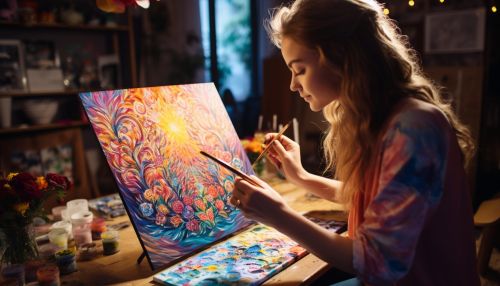Art Therapy
Overview
Art therapy is a form of expressive therapy that uses the creative process of making art to improve a person's physical, mental, and emotional well-being. The creative process involved in expressing one's self artistically can help people to resolve issues as well as develop and manage their behaviors and feelings, reduce stress, and improve self-esteem and awareness.
History
Art therapy has its roots in the fields of art and psychotherapy and may vary in definition. Art therapy may focus on the creative art-making process itself, as therapy, or on the analysis of expression gained through an exchange of patient and therapist interaction. The psychoanalytic approach was one of the earliest forms of art psychotherapy. This approach employs the transference process between the therapist and the client who makes art. The therapist interprets the client's symbolic self-expression as communicated in the art and elicits interpretations from the client. Analysis of transference is no longer always a component of art therapy research or treatment because art therapy can employ a variety of theoretical and methodological approaches.


Techniques and Approaches
Art therapists use various techniques and theoretical orientations for their work, including traditional psychotherapeutic theories such as psychoanalytic or psychodynamic practices, as well as theories from expressive therapies. Some practitioners use a holistic approach, considering a person's physical health, emotional state, psychological well-being, social status, and spiritual beliefs.
Art therapists work with individuals, couples, families or groups in diverse settings such as hospitals, schools, mental health clinics, private practice, and other community facilities. They provide services to people of all ages, races, and ethnic backgrounds who have functional or developmental disabilities, mental health disorders, medical problems, as well as individuals seeking personal growth.
Applications
Art therapy can be used to treat a wide range of mental disorders and psychological distress. In many cases, it might be used in conjunction with other psychotherapy techniques such as group therapy or cognitive-behavioral therapy. It can be used to assist in the improvement of various mental and physical symptoms including, but not limited to, reducing pain, anxiety, and tension. It can also be used to improve cognitive functions, help an individual's self-image, and promote healthy self-esteem and self-awareness.
Benefits
Art therapy has numerous benefits, both physically and mentally. It can help individuals visually express emotions and fears that they may not be able to express through conventional means, and can give them a deeper understanding of their feelings and behavior. Art therapy can also reduce stress, help individuals with mental health disorders, improve cognitive and sensory-motor functions, foster self-esteem and self-awareness, cultivate emotional resilience, promote insight, enhance social skills, and reduce and resolve conflicts and distress.
Criticisms and Challenges
While art therapy has many benefits, it also has its criticisms. Some argue that there is a lack of empirical evidence to support the efficacy of art therapy. Others argue that art therapy is not a standalone treatment and should only be used as an adjunct to other forms of therapy. Additionally, the subjective nature of analyzing art can lead to misinterpretation of a client's artwork, which could potentially cause harm.
